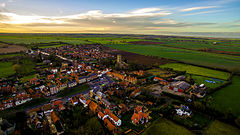Folkingham
| Folkingham | |
|---|---|
 Folkingham |
|
| Folkingham shown within Lincolnshire | |
| Population | 729 (2001) |
| OS grid reference | TF072332 |
| • London | 95 mi (153 km) S |
| District | |
| Shire county | |
| Region | |
| Country | England |
| Sovereign state | United Kingdom |
| Post town | SLEAFORD |
| Postcode district | NG34 |
| Dialling code | 01529 |
| Police | Lincolnshire |
| Fire | Lincolnshire |
| Ambulance | East Midlands |
| EU Parliament | East Midlands |
| UK Parliament | |
Folkingham /ˈfɒkɪŋəm/ is a village and civil parish at the northern edge of the South Kesteven district of Lincolnshire, England. It lies on the A15 road 11 miles (18 km) north of Bourne. The civil parish and ecclesiastical parish have the same boundaries. The 2001 Census recorded a population of 729, increasing to 796 at the 2011 census.
The village has several historic buildings, such as the House of Correction and The Greyhound. The area around the castle site became a designated conservation area in 1968.
Today the local economy is still mainly agriculture-based. Passing through the village are several footpaths; providing one of a number of activities that attract visitors. The New Inn is a pub/restaurant in a 17th-century building in West Street. There is a tea shop and confectioner's in the Market Place.
Folkingham is the home village of Major Lance Gerrard-Wright, the former equerry to the Duke of York and former husband of Ulrika Jonsson.
The place-name Folkingham seems to contain an Old English personal name, Folc(a), + ingahām (Old English), the village of the people of . . . ; the village of the people called after . . .so perhaps 'Homestead or village of Folc's or Folca's people'. Folkingham appears in the Domesday survey of 1086 as Folchingeham, Folchingham and Fulchingeham.
A castle was built in the 12th century by Gilbert de Gant, Earl of Lincoln and enlarged by Henry Beaumont in the 14th century. He was given a licence to crenelate it in 1312. The last documentary record of occupation of this castle dates from 1372. John Leland described it as a ruin in 1535, in which state it survived until the Civil war. The site was later used as the village house of correction.
...
Wikipedia

